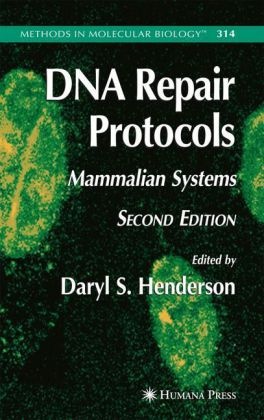Mehr lesen
Zusatztext "...It will serve as an essential reference for both the practical and theoretical aspects of DNA repair studies, encourage the transfer of methodologies between model systems, and stimulate the development of new approaches." - Anticancer Research "...must for any science library supporting a molecular biology program." - E-Streams "An informative collection of techniques and protocols for characterizing and utilizing DNA repair activities and enzymes from some of the leading names in DNA repair field. This collection of protocols is ideal for both the novice in the field and to the experienced applied researcher." - Lavoisier Librairie "...an extremely useful resource for any laboratory with an interest in the vibrant field of DNA repair. Any good laboratory manueal should be not only a useful reference guide but also a source of inspiration, and it is undoubtedly true that DNA Repair Protocols: Mammalian Systems succeeds on both counts." -Int. J. Radiation Oncology Biol. Phys. "This is the definite book on the subject not only for those working in the field of DNA repair but also for those interested in genetic toxicology and chemical safety." -BTS Newsletter Klappentext In this second edition of a much praised laboratory manual devoted to eukaryotic systems, Daryl S. Henderson has refocused the book on mammalian cells, adding fourteen entirely new chapters and extensively revising many of the remaining chapters. The authors address a broad range of questions about practical mammalian DNA repair, including such arcana as "what is radioresistant DNA synthesis and how is it measured?" The techniques presented are readily reproducible and offer cutting-edge methods for cytogenetic analysis, measuring the cellular response to ionizing radiation, detecting single-strand (nicks) and double-strand DNA breaks, detecting the presence of "adducted" bases in DNA, and preparing mismatch repair (MMR) plasmid substrates. Among the highlights are excellent coverage of both base excision repair (BER) and nucleotide excision repair (NER), useful assays for identifying and quantifying UV-induced DNA lesions and DNA breakage, gene therapy, environmental mutagenesis and cancer, and gene targeting. The protocols follow the successful Methods in Molecular Biology™ series format, each offering step-by-step laboratory instructions, an introduction outlining the principles behind the technique, lists of the necessary equipment and reagents, and tips on troubleshooting and avoiding known pitfalls. Authoritative and highly practical, DNA Repair Protocols: Mammalian Systems, Second Edition, offers investigators a wide variety of productive methods to explore and make new discoveries in the world of mammalian DNA repair. Zusammenfassung The first edition of this book, published in 1999 and called DNA Repair Protocols: Eukaryotic Systems, brought together laboratory-based methods for studying DNA damage and repair in diverse eukaryotes: namely, two kinds of yeast, a nematode, a fruit fly, a toad, three different plants, and human and murine cells. This second edition of DNA Repair Protocols covers mammalian cells only and hence its new subtitle, Mammalian Systems. There are two reasons for this fresh emphasis, both of them pragmatic: to cater to the interests of what is now a largely mammalocentric DNA repair field, and to expedite editing and prod- tion of this volume. Although DNA Repair Protocols: Mammalian Systems is a smaller book than its predecessor, it actually contains a greater variety of methods. Fourteen of the book’s thirty-two chapters are entirely new and areas of redundancy present in the first edition have been eliminated here (for example, now just two chapters describe assays for nucleotide excision repair [NER], rather than seven). All eighteen returning chapters have been revised, many of them ext- sively. In order to maintain a co...

